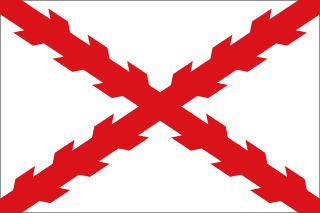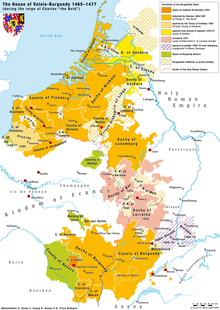
The European region known as the Low Countries, historically once also known as the Netherlands, or Belgica, is a coastal lowland region in Northwestern Europe forming the lower basin of the Rhine–Meuse–Scheldt delta and consisting today of the three modern "Benelux" countries: Belgium, Luxembourg, and the Netherlands – which English and French give the same name as the traditional regional name. Geographically and historically, the area also includes parts of France and Germany such as French Flanders and the German regions of East Frisia and Cleves. During the Middle Ages, the Low Countries were divided into numerous semi-independent principalities.

The Seventeen Provinces were the Imperial states of the Habsburg Netherlands in the 16th century. They roughly covered the Low Countries, i.e., what is now the Netherlands, Belgium, Luxembourg, and most of the French departments of Nord and Pas-de-Calais (Artois). Also within this area were semi-independent fiefdoms, mainly ecclesiastical ones, such as Liège, Cambrai and Stavelot-Malmedy.

The Southern Netherlands, also called the Catholic Netherlands, were the parts of the Low Countries belonging to the Holy Roman Empire which were at first largely controlled by Habsburg Spain and later by the Austrian Habsburgs until occupied and annexed by Revolutionary France (1794–1815).
Duke of Burgundy was a title used by the rulers of the Duchy of Burgundy, from its establishment in 843 to its annexation by France in 1477, and later by members of the House of Habsburg, including Holy Roman emperors and kings of Spain, who claimed Burgundy proper and ruled the Burgundian Netherlands.

The Duchy of Burgundy emerged in the 9th century as one of the successors of the ancient Kingdom of the Burgundians, which after its conquest in 532 had formed a constituent part of the Frankish Empire. Upon the 9th-century partitions, the French remnants of the Burgundian kingdom were reduced to a ducal rank by King Robert II of France in 1004. Robert II's son and heir, King Henry I of France, inherited the duchy but ceded it to his younger brother Robert in 1032.

The County of Artois was a historic province of the Kingdom of France, held by the Dukes of Burgundy from 1384 until 1477/82, and a state of the Holy Roman Empire from 1493 until 1659.

In the history of the Low Countries, the Burgundian Netherlands or the Burgundian Age is the period between 1384 and 1482, during which a growing part of the Low Countries was ruled by the Dukes of Burgundy. Within their Burgundian State, which itself belonged partly to the Holy Roman Empire and partly to the Kingdom of France, the dukes united these lowlands into a political union that went beyond a personal union as it gained central institutions for the first time.

Spanish Netherlands was the Habsburg Netherlands ruled by the Spanish branch of the Habsburgs from 1556 to 1714. They were a collection of States of the Holy Roman Empire in the Low Countries held in personal union by the Spanish Crown. This region comprised most of the modern states of Belgium and Luxembourg, as well as parts of northern France, the southern Netherlands, and western Germany with the capital being Brussels. The Army of Flanders was given the task of defending the territory.

The Duchy of Limburg or Limbourg was an imperial estate of the Holy Roman Empire. Much of the area of the duchy is today located within Liège Province of Belgium, with a small portion in the municipality of Voeren, an exclave of the neighbouring Limburg Province. Its chief town was Limbourg-sur-Vesdre, in today's Liège Province.

The Burgundian Circle was an Imperial Circle of the Holy Roman Empire created in 1512 and significantly enlarged in 1548. In addition to the Free County of Burgundy, the Burgundian Circle roughly covered the Low Countries, i.e., the areas now known as the Netherlands, Belgium and Luxembourg and adjacent parts in the French administrative region of Nord-Pas-de-Calais. For most of its history, its lands were coterminous with the holdings of the Spanish Habsburgs in the Empire.

The Duchy of Brabant, a state of the Holy Roman Empire, was established in 1183. It developed from the Landgraviate of Brabant of 1085–1183, and formed the heart of the historic Low Countries. The Duchy comprised part of the Burgundian Netherlands from 1430 and of the Habsburg Netherlands from 1482, until it was partitioned after the Dutch revolt of 1566–1648.

The Cross of Burgundy is a saw-toothed form of the Cross of Saint Andrew, the patron saint of Burgundy, and a historical banner and battle flag used by holders of the title of Duke of Burgundy and their subjects.

The Duchy of Luxemburg was a state of the Holy Roman Empire, the ancestral homeland of the noble House of Luxembourg. The House of Luxembourg, now Duke of Limburg, became one of the most important political forces in the 14th century, competing against the House of Habsburg for supremacy in Central Europe. They would be the heirs to the Přemyslid dynasty in the Kingdom of Bohemia, succeeding the Kingdom of Hungary and contributing four Holy Roman Emperors until their own line of male heirs came to an end and the House of Habsburg got the pieces that the two Houses had originally agreed upon in the Treaty of Brünn in 1364.

The House of Valois-Burgundy, or the Younger House of Burgundy, was a noble French family deriving from the royal House of Valois. It is distinct from the Capetian House of Burgundy, descendants of King Robert II of France, though both houses stem from the Capetian dynasty. They ruled the Duchy of Burgundy from 1363 to 1482 and later came to rule vast lands including Artois, Flanders, Luxembourg, Hainault, the county palatine of Burgundy (Franche-Comté), and other lands through marriage, forming what is now known as the Burgundian State.

Habsburg Netherlands was the Renaissance period fiefs in the Low Countries held by the Holy Roman Empire's House of Habsburg. The rule began in 1482, when the last Valois-Burgundy ruler of the Netherlands, Mary, wife of Maximilian I of Austria, died. Their grandson, Emperor Charles V, was born in the Habsburg Netherlands and made Brussels one of his capitals.

Upper Guelders or Spanish Guelders was one of the four quarters in the Imperial Duchy of Guelders. In the Dutch Revolt, it was the only quarter that did not secede from the Habsburg monarchy to become part of the Seven United Netherlands, but remained under Spanish rule during the Eighty Years' War.

The Dutch Republic Lion was the badge of the Union of Utrecht, the Republic of the Seven United Netherlands, and a precursor of the current coat of arms of the Kingdom the Netherlands.

In the period 1482–1492, the cities of the County of Flanders revolted twice against Maximilian of Austria, who ruled the county as regent for his son, Philip the Handsome. Both revolts were ultimately unsuccessful.

The Burgundian State is a concept coined by historians to describe the vast complex of territories that is also referred to as Valois Burgundy.
The origins of the Eighty Years' War are complicated, and have been a source of disputes amongst historians for centuries.


















